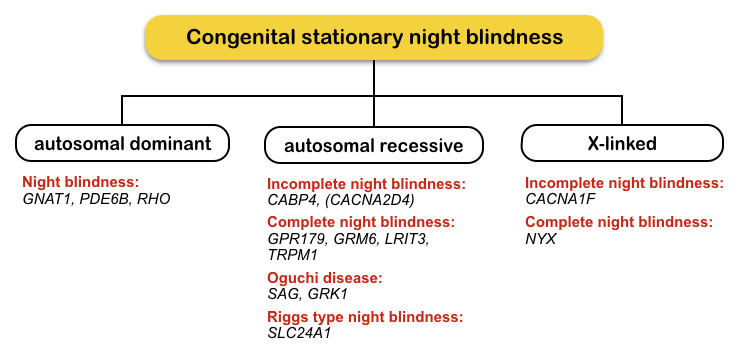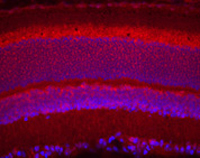Congenital Stationary Night Blindness
Congenital stationary night blindness (CSNB) is a non-progressive disorder with reduced/abnormal nocturnal vision of different degrees. The fundus of patients can be normal or conspicuous.
Three types of CSNB with normal fundus can be discriminated: the Schubert-Bornschein type, the Riggs type, and the Nougaret type. The mode of inheritance can be autosomal dominant or recessive, or X linked. Abnormal nocturnal vision in patients can also be associated with additional ocular symptoms including myopia, nystagmus, and strabismus. The Schubert-Bornschein type is characterized by a negative electroretinogram (ERG), where the amplitude of the b-wave is smaller than that of the a-wave. The complete form (CSNB1) of this type of CSNB shows a very low or absent response of the rod b-wave upon electroretinography but almost normal cone response, while the incomplete form (CSNB2) appears with a reduced rod and cone response. For more information please refer to Zeitz C (2007), Expert Rev. Ophthalmol. 2:467-484.

We have identified several genes which carry mutations in patients with CSNB and currently offer clinical testing for mutations in the following genes: NYX, CACNA1F, GRM6, CABP4, and RHO. For details on genetic testing please refer to the respective section of our homepage. Genetic Testing
Current research is focusing on a detailed functional characterization of mutations in the different genes and also the identification of novel genes and mutations.
Mutations in CACNA2D4 can also lead to autosomal recessive CSNB, but the disease is slightly progressive and can result in a mild form of cone dystrophy later in life. We have mapped and cloned this gene in a mouse model with characteristic ERG abnormalities and later identified mutations in a family.
TEAM MEMBERS
Wolfgang Berger (PhD)
Samuel Koller (PhD)
